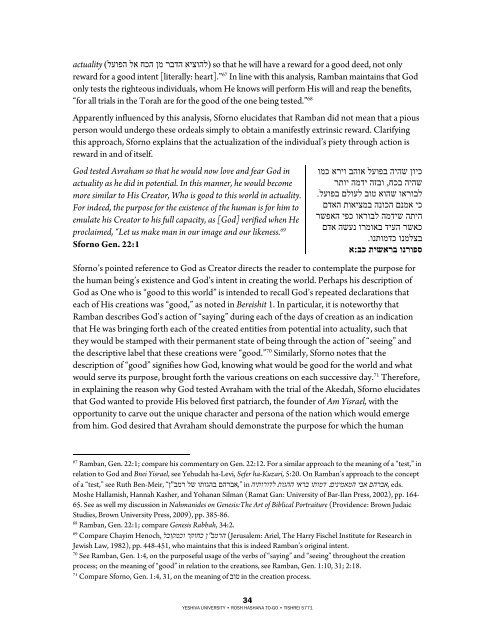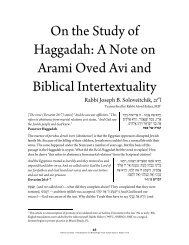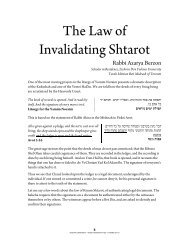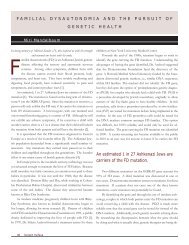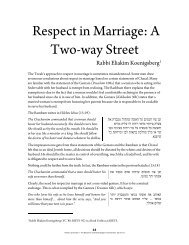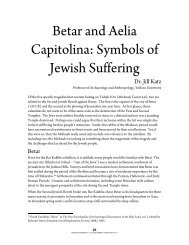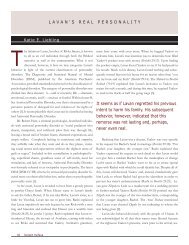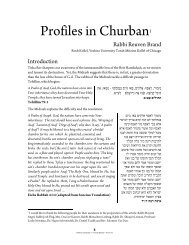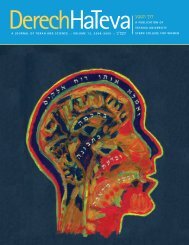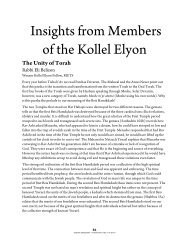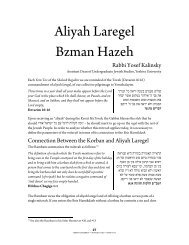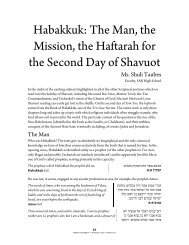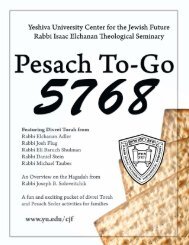YESHIVA UNIVERSITY • ROSH HASHANA TO-GO ... - YUTorah.org
YESHIVA UNIVERSITY • ROSH HASHANA TO-GO ... - YUTorah.org
YESHIVA UNIVERSITY • ROSH HASHANA TO-GO ... - YUTorah.org
Create successful ePaper yourself
Turn your PDF publications into a flip-book with our unique Google optimized e-Paper software.
actuality ( לעופה לא חכה ןמ רבדה איצוהל)<br />
so that he will have a reward for a good deed, not only<br />
reward for a good intent [literally: heart].” 67 In line with this analysis, Ramban maintains that God<br />
only tests the righteous individuals, whom He knows will perform His will and reap the benefits,<br />
“for all trials in the Torah are for the good of the one being tested.” 68<br />
Apparently influenced by this analysis, Sforno elucidates that Ramban did not mean that a pious<br />
person would undergo these ordeals simply to obtain a manifestly extrinsic reward. Clarifying<br />
this approach, Sforno explains that the actualization of the individual’s piety through action is<br />
reward in and of itself.<br />
God tested Avraham so that he would now love and fear God in<br />
actuality as he did in potential. In this manner, he would become<br />
more similar to His Creator, Who is good to this world in actuality.<br />
For indeed, the purpose for the existence of the human is for him to<br />
emulate his Creator to his full capacity, as [God] verified when He<br />
proclaimed, “Let us make man in our image and our likeness. 69<br />
Sforno Gen. 22:1<br />
34<br />
<strong>YESHIVA</strong> <strong>UNIVERSITY</strong> <strong>•</strong> <strong>ROSH</strong> <strong>HASHANA</strong> <strong>TO</strong>-<strong>GO</strong> <strong>•</strong> TISHREI 5771<br />
ומכ אריו בהוא לעופב היהש ןויכ<br />
רתוי המדי הזבו , חכב היהש<br />
. לעופב םלועל בוט אוהש וארובל<br />
םדאה תואיצמב הנוכה םנמא יכ<br />
רשפאה יפכ וארובל המדיש התיה<br />
םדא השענ ורמואב דיעה רשאכ<br />
. ונתומדכ ונמלצב<br />
א:<br />
בכ תישארב ונרופס<br />
Sforno’s pointed reference to God as Creator directs the reader to contemplate the purpose for<br />
the human being’s existence and God’s intent in creating the world. Perhaps his description of<br />
God as One who is “good to this world” is intended to recall God’s repeated declarations that<br />
each of His creations was “good,” as noted in Bereishit 1. In particular, it is noteworthy that<br />
Ramban describes God’s action of “saying” during each of the days of creation as an indication<br />
that He was bringing forth each of the created entities from potential into actuality, such that<br />
they would be stamped with their permanent state of being through the action of “seeing” and<br />
the descriptive label that these creations were “good.” 70 Similarly, Sforno notes that the<br />
description of “good” signifies how God, knowing what would be good for the world and what<br />
would serve its purpose, brought forth the various creations on each successive day. 71 Therefore,<br />
in explaining the reason why God tested Avraham with the trial of the Akedah, Sforno elucidates<br />
that God wanted to provide His beloved first patriarch, the founder of Am Yisrael, with the<br />
opportunity to carve out the unique character and persona of the nation which would emerge<br />
from him. God desired that Avraham should demonstrate the purpose for which the human<br />
67 Ramban, Gen. 22:1; compare his commentary on Gen. 22:12. For a similar approach to the meaning of a “test,” in<br />
relation to God and Bnei Yisrael, see Yehudah ha-Levi, Sefer ha-Kuzari, 5:20. On Ramban’s approach to the concept<br />
of a “test,” see Ruth Ben-Meir, “ ן " במר לש ותוגהב םהרבא,”<br />
in היתורודל תוגהה יארב ותומד םינימאמה : יבא םהרבא,<br />
eds.<br />
Moshe Hallamish, Hannah Kasher, and Yohanan Silman (Ramat Gan: University of Bar-Ilan Press, 2002), pp. 164-<br />
65. See as well my discussion in Nahmanides on Genesis:The Art of Biblical Portraiture (Providence: Brown Judaic<br />
Studies, Brown University Press, 2009), pp. 385-86.<br />
68 Ramban, Gen. 22:1; compare Genesis Rabbah, 34:2.<br />
69 Compare Chayim Henoch, לבוקמכו רקוחכ ן " במרה (Jerusalem: Ariel, The Harry Fischel Institute for Research in<br />
Jewish Law, 1982), pp. 448-451, who maintains that this is indeed Ramban’s original intent.<br />
70 See Ramban, Gen. 1:4, on the purposeful usage of the verbs of “saying” and “seeing” throughout the creation<br />
process; on the meaning of “good” in relation to the creations, see Ramban, Gen. 1:10, 31; 2:18.<br />
71 Compare Sforno, Gen. 1:4, 31, on the meaning of בוט in the creation process.


